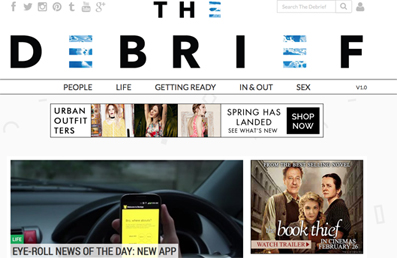Native ads: The Debrief, going mainstream and legal concerns when hitting it big
 News came last week that Bauer Media was launching a multi-platform title called The Debrief. There’s no great shock in a magazine publisher launching a new digital brand aimed at ABC1 20-something women, but the difference with The Debrief is that it plans to make its money by eschewing traditional banner ads in favour of native ads buried amongst its editorial content.
News came last week that Bauer Media was launching a multi-platform title called The Debrief. There’s no great shock in a magazine publisher launching a new digital brand aimed at ABC1 20-something women, but the difference with The Debrief is that it plans to make its money by eschewing traditional banner ads in favour of native ads buried amongst its editorial content.
For the uninitiated, native ads are essentially pieces of promotional content designed to fit with the look, feel, and tone of a specific digital publishing platform. Some publishers claim they aren’t even a new phenomenon (advertorials anyone?), but the point is that 18 months ago saying ‘native ads’ to a brand manager might cause them to stare back as if you were talking Swahili. Say it to them now, and they’ll tell you it’s a phenomenon in which they’re extremely interested.
A survey by the Online Publishers Association found that 73% of US publishers now carried native ads, with a further 17% planning to get in on the act within 12 months. Yes, native ads have hit the mainstream and their use has grown quickly.
The difference with The Debrief is that it isn’t just using native ads as one of many revenue generating tools, the brand has focused its revenue generating efforts almost completely on them. That’s a change to how most publishers or brands use native ads – and something we’ll probably see more of thanks to Buzzfeed’s success with a similar strategy.
The Debrief isn’t even the first brand to follow Buzzfeed’s strategy. Last month, Yahoo CEO Marissa Mayer outlined how her firm was launching new technology and food websites that would eschew under-performing banner adverts and instead rely on native ads designed to mirror the look of each site’s own content.
On Yahoo! Food, native ads are differentiated from ‘pure’ editorial content with a ‘Promoted’ home page sub-heading, but this is the only differentiator. The sponsored content is otherwise integrated alongside the editorial. On the page, a ‘brought to you by’ announcement indicates the content is sponsored. A logo also features, typically in the top right slot where readers are used to seeing banner ads.
It’s likely native ads carried on The Debrief will mirror the way ad content is carried on Yahoo! Food. They’ll likely be mixed with editorial content across its five content areas – People, Life, Getting Ready, Sex and In/Out – and similarly flagged as promotional copy.
It doesn’t take a great leap of imagination to see how ad content could also be seamlessly interspersed into the clever steam of selfies and other small bits of content pumped through The Debrief’s extensive presence on Instagram, Facebook, Youtube, Twitter and Pinterest.
It’s no great surprise publishers are getting increasingly interested in native ads, advertisers seem to love the format and are increasingly keen to experiment with new digital and social media platforms as they struggle to reach younger audiences. Native ads provide brands with a great way to communicate a message and – if the placement is right – fix in the mind a reader an association with the qualities of the host publisher or platform.
Brands are expected to spend 24 per cent of their budgets on native ads within a year, according to a Hexagram survey, quickly turning it into a mainstream revenue stream with sizeable reach and scale. But there in lies a problem. In an age of tracking and quantifying marketing spend, it’s not easy to see how effective ads can be on anything other than a small scale and over a relatively short term. How do you build ads that are scalable for a mass audience, then make sure they work well over a long period?
Building scale and durability aren’t the only problems that this new ad format could face. Lawyers have warned that with greater use comes the attention of regulators who might take an interest in those potential grey area using native ads can create.
Mark Owen, partner with legal firm Taylor Wessing, wrote recently in Marketing magazine that:
“Unless labelled as advertising it can be indistinguishable from the content which surrounds it, and there are clear risks that consumers may be misled. There are also risks for publishers that they will be seen as biased, and their editorial independence compromised.”
Owen raised three key questions:
- What form should labelling take? When should it appear? What kind of education will consumers need about those labels?
- Should the publisher take any responsibility for what is said in an advertising article? How would responsibility be divided between advertiser and publisher?
- Once those ads get pushed into automated news feeds that push stories to other sites and devices, who then bares the burden of responsibility for legal compliance?
At the moment most publishers have their own rules on the use of native ads, and the IBA has published some best practice guidelines, but until a regulatory body lays down some firm proposals on who is ultimately responsible for this content, then there is always the risk of consumers feeling like they’ve been duped and advertisers not really getting the best out of their ads in the long-term.
NB: Even if the number of publishers taking up native ads isn’t a thrill for you, those OPA findings mentioned above are worth a look. Native advertising is a vague term at best, so the OPA asked it respondents to try and pin down exactly what constitutes ‘native advertising’ .